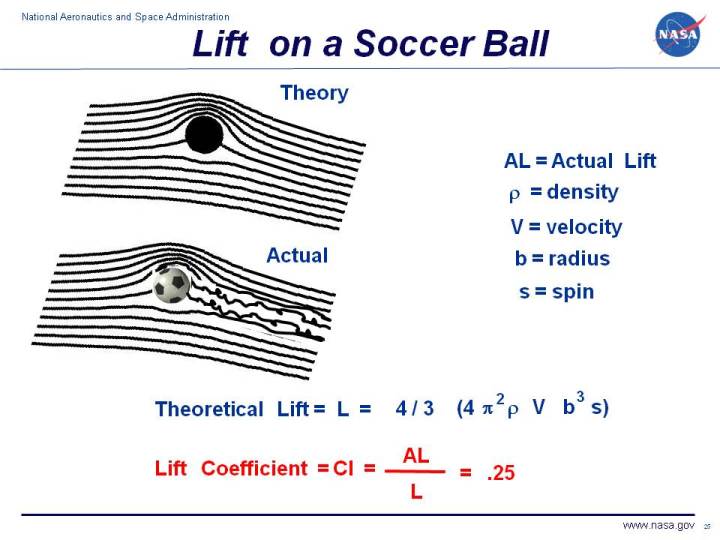
As an object moves through the air, the air is disturbed by
the object. The disturbance generates an
aerodynamic force
on the object. Since a force is a
vector quantity,
having both a magnitude and a direction, we can
split
the aerodynamic force into two components.
Drag acts in the direction
of travel of the object.
Lift acts perpendicular
to the direction of travel.
Many different
objects
are capable of generating a lift force.
In particular, a
spinning ball
generates a force that is perpendicular to both the flow
direction and to the axis of rotation.
The lift force generated by a spinning soccer ball is the origin of the
"bend", a curved kick to elude the goal keeper.
For a "bend", the direction of the lift force is used to
move the ball parallel to the surface of the earth, from side to side.
The lift force on a soccer ball can also be used to loft or dive the ball.
On this page we will discuss some of the details of the lift of a soccer ball.
The details of how a moving soccer ball creates lift are fairly complex.
If we move with an object through the air,
the object appears to stand still and the
air moves past the object at the speed of the object.
Next to the surface of the object, the molecules of the air
stick to
the surface, as discussed in the
properties of air slide. This thin
layer of molecules entrains or pulls the surrounding flow
of air.
For a spinning ball the external flow is pulled
in the direction of the spin. If the ball is not
translating,
we have a spinning, vortex-like flow set up around
the spinning ball, neglecting three-dimensional and
viscous effects in the outer flow.
If the ball is translating through the air at
some velocity, then on one side of the ball the entrained flow opposes
the free stream flow, while on the other side of the ball, the
entrained and free stream flows are in the same direction.
Adding the components of velocity for the entrained flow to the free
stream flow, on one side of the ball the net velocity is less
than free stream; while on the other, the net velocity is
greater than free stream. The flow is then turned by the
spinning ball, and a force is
generated. Because of the change to the velocity field, the pressure
field is also altered around the ball. The magnitude of the
force can be computed by
integrating
the surface pressure times the area around the ball.
The direction of the force is
perpendicular (at a right angle) to the flow direction
and to the axis of rotation. On
another page
we develop the mathematical equation for the ideal theoretical lift of a
spinning, smooth ball.
L = (4 * pi^2 * b^3 * s * rho * V) * 4 / 3
where b is the radius of the ball, s is the spin of the ball,
rho is the density of the air, V is the velocity of the ball,
and pi is the standard 3.1415...
The equation given above describes the theoretical lift force generated
on a smooth, rotating ball. The ideal
streamlines
around a smooth ball are shown on the figure at the top left, marked
"Theory".
But in reality, the flow around a spinning soccer ball is very complex
and looks more like the "Actual" flow shown on the figure.
Viscosity generates a boundary layer on the ball and
the stitches used to hold the covering of the ball together
stick up out of the boundary layer and disturb both the boundary layer
and free stream flow.
On the ball, the boundary layer transitions to
turbulent flow
which affects the amount of
aerodynamic force.
The stitches are not symmetrically distributed around the ball.
So the real flow around the ball is separated, unsteady, and
not uniform.
We can use the theoretical lift as a first order,
or preliminary, estimate of the lift on a soccer ball.
But to account for these real-world effects that we have neglected
in our ideal flow model, we define a
lift coefficient.
The lift coefficient is an experimentally determined factor that
is multiplied times the ideal lift value to produce a real lift value.
The ideal simplified model
tells us the relative importance of the
factors
that affect the lift force on the soccer ball, while all of the complex factors
are modeled by the lift coefficient.
Using experimental data for the
movement
of a kicked ball, Goff and Carre determined the average value of the lift
coefficient to be about .25.
We have used this value as the default value for the lift coefficient in the
SoccerNASA simulation program
You can further investigate the lift of a spinning soccer ball
by changing the value of any of the factors that affect lift in the program.
The lift force on the soccer ball is very similar to the lift
generated by an
airplane wing or a big league
curve ball.
Activities:
Guided Tours
Navigation ..

- NASA Soccer Home Page
- Beginner's Guide Home Page
|
